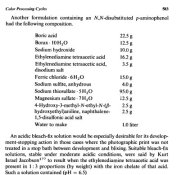I need to find some alternatives of Agfacolor 92 and E2 process for paper.
I have A LOT of old Agfacolour roll of paper (in really good condition and still usable) that needed to be proceed in 92/E2.
I'm going to run out of this old chemistry and there is no way to throw away all my stock or wait 6 month a seller on ebay.
So I need to find some actual process who can fit this paper. I've found some advice for Agfacolour's reversal film, for c22 cross process, to process film in a c41 low temperature (strange because c41 is CD4 and 92/E is CD3)... But nobody is talking about processing paper.
I Know that 92/E2 are bromide based processes so RA4 won't work correctly. But I've found a guy who talked about adding some Benzyl Alcohol in the process (I don't know when) and a Ph adjustment (I don't know where)...
I also know that C41 is bromide based but CD4 so it can work but not perfectly.
I don't know if E6 can work and I know there's some moovies process based on bromide and using CD3
So I have several ideas but no real solution and it's a mess in my head. I have been thinking about trying to find the solution empirically for a while but it would save me a lot of time if someone could enlighten me on the subject.
I use this paper that has a negative on pinhole or large format chamber so the more precise, the better.
I'll be grateful for any advice
Ugo
I have A LOT of old Agfacolour roll of paper (in really good condition and still usable) that needed to be proceed in 92/E2.
I'm going to run out of this old chemistry and there is no way to throw away all my stock or wait 6 month a seller on ebay.
So I need to find some actual process who can fit this paper. I've found some advice for Agfacolour's reversal film, for c22 cross process, to process film in a c41 low temperature (strange because c41 is CD4 and 92/E is CD3)... But nobody is talking about processing paper.
I Know that 92/E2 are bromide based processes so RA4 won't work correctly. But I've found a guy who talked about adding some Benzyl Alcohol in the process (I don't know when) and a Ph adjustment (I don't know where)...
I also know that C41 is bromide based but CD4 so it can work but not perfectly.
I don't know if E6 can work and I know there's some moovies process based on bromide and using CD3
So I have several ideas but no real solution and it's a mess in my head. I have been thinking about trying to find the solution empirically for a while but it would save me a lot of time if someone could enlighten me on the subject.
I use this paper that has a negative on pinhole or large format chamber so the more precise, the better.
I'll be grateful for any advice

Ugo
Last edited:















